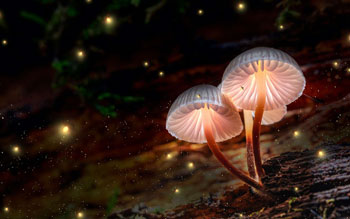|
This is a theory put forward in a recently published study by a British researcher. The "mushroom language" would have up to 50 symbolic sequences, which can be compared to words.
BY MARGOT HINRY
PUBLISHED 29 APR. 2022 At 02:28 PM

A British researcher has closely studied the electrical activity of four species of fungi. Ghost Mushroom (Omphalotus nidiformis), Enoki Mushroom (Flammulina velutipes), Gill Mushroom (Schizophyllum commune) and Caterpillar Mushroom (Cordyceps militaris). Among the hypotheses set out in the conclusions of the study, published in the journal The royal society open science, there is that of a mushroom "language". These living beings would "exchange" not words, but symbolic sequences.
The study of the electrical activity of fungi dates back to the 1970s according to Andrew Adamatzky, of the University of Bristol. First thanks to the cellular recording, which would have made it possible to discover "spikes" which are similar to "action potentials". Over the years, many scientists have studied this question.
In 2018, Andrew Adamatzky recorded the extracellular electrical potential of the fruit bodies of pink oyster mushrooms (Pleurotus djamor). He explains that thus, "two types of doping activity are highlighted: high frequency (2.6 min period) and low frequency (14 min period)" and adds that there is here "evidence that the Electrical doping behavior changes in response to thermal and tactile stimulation. »
Today, the British researcher runs, among other things, a computer lab where he designs prototype devices to sense and compute “with a wide range of biological, chemical and physical substrates. »
Andrew Adamatzky clarifies that in order to be able to design computing devices based on fungi, he must first understand "how information is transferred and processed in mycelium networks". The study published in early April is the result of these questions, namely how a calculation can be made within a network of mycelium.
The "mushroom language" would have up to 50 symbolic sequences, which can be compared to words.
PHOTOGRAPH BY ANDREW ADAMATZKY
The researcher says it's likely that these spikes of electrical action are "by-products of calcium waves." The latter are, according to him, used by fungi for three reasons. First, maintaining their integrity. The expert compares this to the cries of wolves, "to signal each other's presence" and keep the pack together. Second, to "signall other parts of the mycelium to find sources of attractants and repellents" and then to transport water and nutrients "along the mycelium".
The study also specifies that the electrical impulses increase when the roots of the fungus analyzed are in direct contact with wood. The professor believes that these living beings could use this "mushroom tongue" to communicate information regarding food or potential injury "with distant parts of themselves or related partners, such as trees."
CAPTURING ELECTRICAL ACTIVITY IN A MUSHROOM In order to capture these peaks and be able to analyze them, the researcher first inserted electrodes into a substrate that had been "colonized by fungal mycelium". It was through these electrodes that Andrew Adamatzky was able to discover "train-like" spikes of electrical activity.
By collecting these elements and analyzing them, the researcher was able to make a comparison with data related to human languages. "I found similarities" says the researcher who compares this data in particular to English and Russian. "The average length of fungal words across four species and two methods of cobs grouping is 5.97, which is on the order of the average word length in some human languages, e.g. 4.8 in English and 6 in Russian ".
The fungal communication theory is unproven. The researcher insists on this point and specifies that these are speculations based on what he was able to observe during his work. The whole study still deserves a lot of research and critical hypothesis testing.
Moreover, he himself specifies that with each theory, he also considers the one where it is not a question of communication or language. "There is also another option: they don't say anything," suggests the researcher. In this case, "the propagating mycelium tips are electrically charged", so as they pass through the electrodes, a spike within "the potential difference is registered".
The theories remain open. "Maybe they're time-encoding information." Perhaps they are analogous to the voice signaling of cats. Perhaps the language of mushrooms is somewhat similar to the "language" of birds. At this point, the theory needs to be backed up by collecting data from more fungi.
|